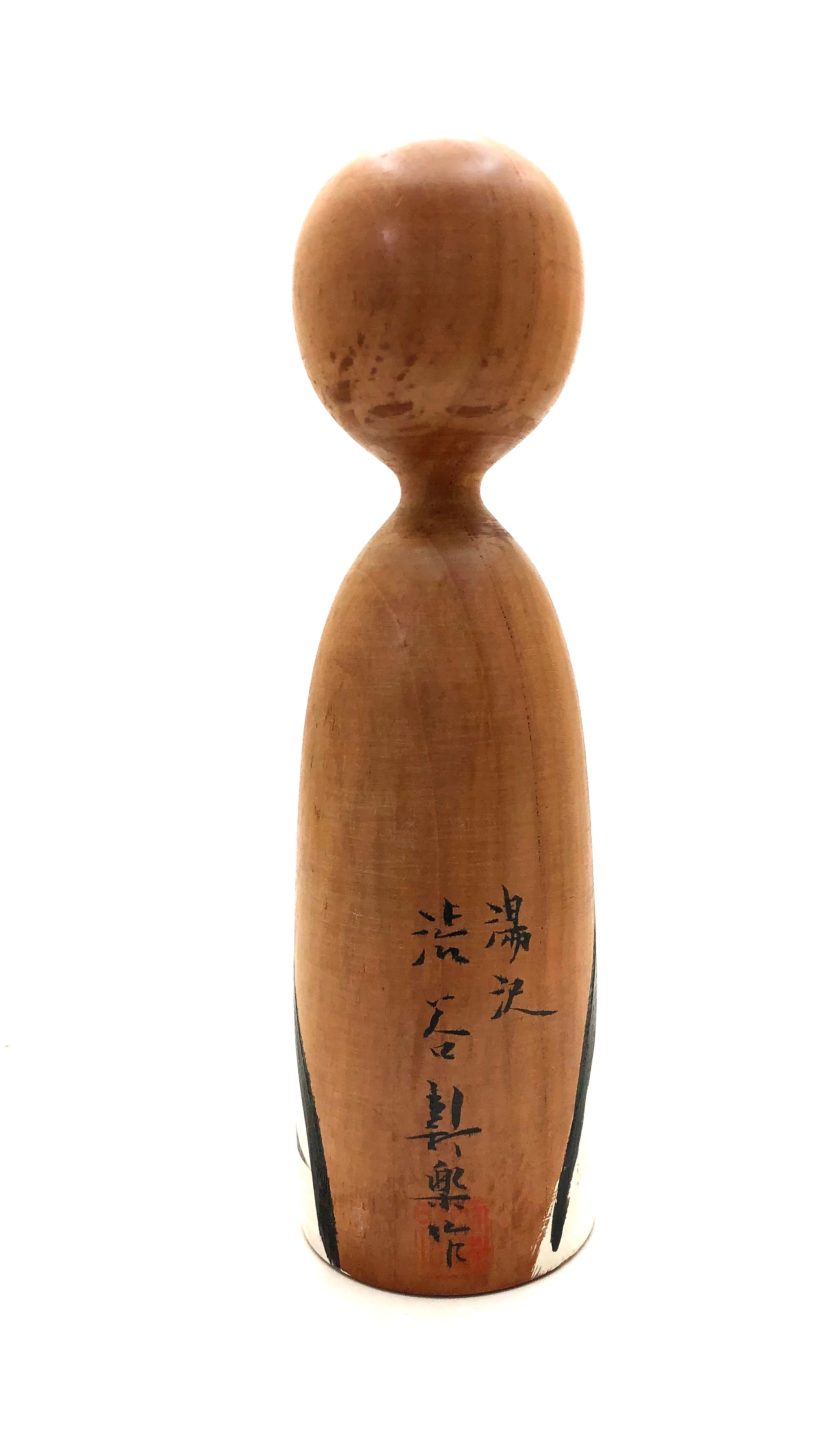


Vintage Sosaku Kokeshi | Transitional Style entitled: “Daruma | Bodhidharma” by Shibuya, Shinraku
Dimensions: 11-0”h
Firstly less discuss what Transitional Style means of this RARE Kokeshi. Transitional identifies that there is a balance of traditional and creative components in its design and in this case incorporates Kijiyama-style treatment of the inverted egg shape head and face with a creative motif being Daruma. These renditions of Daruma, like many in Japan, are made using black and white paint to create the image. White and red are traditionally colors of most Daruma robes.
White, emphasizes learning and knowledge in Buddhism and is said to cut the delusion of ignorance turning into the wisdom of reality. It is the symbol of spiritual and physical purity, and is always present in Shinto rituals. Artists working in the sumi-e’ style of painting achieve a suggestion of detail by using different intensities of ink and line work. Unpainted areas of the doll give form and volume. Here one see the unique Kijiyama neck treatment which is not used in any other family dolls. The lathe-turning allows the graceful flow from the head to the body. Additionally the treatment of the hair with a hair with bangs, and side hair fringes, along with meditative eyes, expressive mouth/lips, long ears and elongated ear lobes ears, (representing religious wisdom, knowledge and compassion), and the characteristic crane shaped eye brows (long life). Here on the body of the doll is shown the founder of Zen Buddhism, enveloped in his white monk’s hooded (cowled) robe. A true symbol of love and harmony. After the turning and carving the figure was finished with a type of natural candle wax,(Rosoku no ro). The name of the piece, with the artist's beautiful hand script signature, and red impressed stamp is on the back of the figure. Only on rare occasions or for a special person did Shibuya-san sign his religious dolls.
For Additional Information on the Kijiyama Family style see: https://mingeiarts.com/collections/kijiyama-kei-family.
Condition: Excellent meaning that the piece retains its original craft/workmanship showing a wonderful-developed patina commensurate which suggests a degree of wear that corresponds to its vintage. It is void of damage, cracks, breakage, or repairs and meets all the standards of the collectible Sosaku Kokeshi.

Artisan
Woodworker: Shibuya, Shinraku
Biographical History:
Transitional artist Shibuya, Shinraku is from Yuzawa City, in Akita Prefecture. Virtually nothing is known about this artist, but it is clear that many of his dolls are in the traditional Kijiyama style, which originated in Yuzawa, Minase, and Inagawa cities. Shibuya-san’s dolls range from the bright and beautifully painted to the skillfully and minimally drawn designs. He is also a prolific artist of Daruma dolls. His work dates from the 1960s onward. There is little biographical data on Shinrak-san, but as collectors, we felt it was most important to represent all Sosaku Kokeshi artists, whether or not each artist has a written account of his/her life. We show the diversity of cultural values and the creative work produced by a multitude of artists.
In researching old writings through articles and books that remain, it is evident that the Kokeshi Craftsperson not only created beautiful forms as toys, but also kept alive cultural values, customs, and fashion through the extensive representations of Kokeshi dolls. The beauty is in the doll and not the signatures, for most masters never signed their dolls. Later they named the dolls, but only when Westerners insisted on signatures because they did not know the artists, so the carvers began to sign their works, for the carvers wanted to promote sales to make a living, during the seasons that did not provide an environment to continue their otherwise daily work.
Collector's note – descriptive qualities, standard characteristics & ornamentation styles:
At New Year’s, most Japanese individuals and corporations buy Daruma dolls and make a resolution for the New Year. The tradition began in the late 17th century as a relief measure for farmers who were suffering from famine.
There are many different styles of Daruma, as you will see by Shibuya’s creations, but there is one philosophy that all of his Daruma share, and that is the pursuit of beauty and artistry through simplicity. Noted is the fact that the images are placed on a large amount of background, which divides the surface and balances the design with space to appreciate the image. Often seen is the use of black and white paint to create the impression. Additionally, we see the celebration of seasonal succession incorporating Iris, Camellia flowers, with many having an emphasis on Bamboo. Artists working in the sumi-e’ style of painting achieve a suggestion of detail by using different intensities of ink and line work. Unpainted areas of the doll give form and volume. It is most interesting that Shibuya continues to use both traditional and creative elements to express his feelings about Japanese life and values.
Explore & Learn More about Woodworker: Shibuya, Shinraku